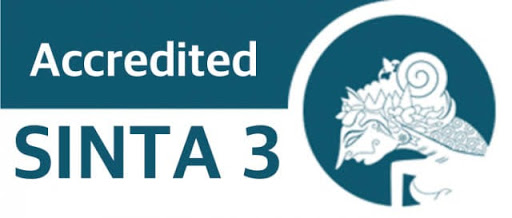Corporate Governance, Transparency and Stock Return Synchronicity
 Abstract Views:
797 times
Abstract Views:
797 times
 PDF Downloads:
537 times
PDF Downloads:
537 times
Abstract
This study aims to analyze the effect of corporate governance on transparency as measured by stock return synchronicity. The variables used are board size (commissioner), big4 audit, institutional ownership, market to book, the volatility of firm fundamentals, leverage, and firm size. This study uses a quantitative approach with multiple linear analysis models. This study uses a sample of non-financial business entities listed on the Indonesia Stock Exchange (BEI). The number of samples used in this study was 198 observations. The results showed that the variable board size (commissioner), institutional ownership, and leverage had a positive effect on transparency, and the implied volatility of the firm hurt transparency. Other variables such as big4 audit, market to book ratio, and firm size do not affect transparency.
Downloads
References
Berenson, M. L., et al., 2012, Basic Business Statistics Concept and Application 12th Edition, Prentice Hall.
Dharmastuti,Christiana Fara, 2003, Analisis Pengaruh Mekanisme Internal dan External Corporate governance terhadap Profitabilitas dan Kebijakan Dividen, Jurnal Organisasi dan Manajemen, Vol.9:21-30.
Gul, F.A, Jeong-Bon Kim, dan Annie A.Qiu, 2010, Ownership Concentration, Foreign Shareholder, Audit Quality, dan Stock Price Synchronicity: Evidence from China, Journal of Financial Economics, Vol.95:425-442.
Heng An dan Ting Zhang, 2013, Stock Price Synchronicity, Crash Risk, dan Institutional Investor, Journal of Corporate Finance, Vol.21:1-15.
Huafang, Xiao dan Yuan Jianguo, 2007, Ownership structure, board composition and corporate voluntary disclosure: Evidence from listed companies in China, Managerial Auditing Journal, Vol.22: 604-619.
Indriani, Erna Wati, 2013, Faktor-Faktor yang Mempengaruhi Luas Pengungkapan Sukarela dan Implikasinya terhadap Asimetri Informasi, Skripsi, Fakultas Ekonomi, Universitas Negeri Semarang: Semarang.
Jensen, M.C., 1993, The modern industrial revolution, exit, and the failure of internal control systems, Journal of Finance, Vol.48:831-880.
Lipton, Martin dan Jay W. Lorsch, 1992, A Modest Proposal for Improved Corporate Governance, The Business Lawyer, Vol.48:59-77.
Nindita,Chairunissa dan Sylvia Veronica Siregar, 2012, Analisis Pengaruh Ukuran Kantor Akuntan Publik terhadap Kualitas Audit di Indonesia, Jurnal Akuntansi dan keuangan, Vol.14:91-104.
Ntow-Gyamfi, Matthew, G.A.Bokpin, dan A.Gamegah, 2015, Corporate Governance and Transparancy: Evidence from Return Synchronicity, Journal Of Financial Economic Policy, Vol.7: 157-179.
Piotroski, Joseph D. dan Barren T. Roulstone, 2004, The Influence of Analysts, Institutional Investors, and Insiders on the Incorporation of Market, Industry, and Firm-Specific Information into Stock Prices, The Accounting Review, Vol.79: 1119-1151.
Sebayang, Esynasali Violetta, 2014, Analisis Faktor yang Mempengaruhi Audit Delay, Skripsi, Fakultas Ekonomika dan Bisnis Universitas Diponegoro: Semarang.
Tas, Oktay dan Selin Duz Tan, 2016, Corporate Governance, Foreign Ownership, dan Stock Price Synchronicity: Evidence from Borsa Istanbul, Journal of Economic, Finance and Accounting, Vol 3:156-165.
Torchia, Mariateresa dan Andrea Calabro, 2016, Board of directors and financial transparency and disclosure:Evidence from Italy, Corporate Governance, Vol.16: 593-608.
Yermack, David, 1996, Higher Market Valuation of Companies with a Small Board of Directors, Journal of Financial Economics, Vol.40:185-211.
Zou,Lipping, William Wilson, dan Shijie Jia, 2017, Do Qualified Foreign Institutional Investor Improve Information Efficiency: A Test Of Stock Price Synchronicity in China?, Asian Economic and Financial Review, Vol.7:456-469.

This work is licensed under a Creative Commons Attribution 4.0 International License.
Articles published in Journal of Entrepreneurship & Business are licensed under a Creative Commons Attribution 4.0 International (CC BY) license. You are free to copy, transform, or redistribute articles for any lawful purpose in any medium, provided you give appropriate credit to the original author(s) and the journal, link to the license, and indicate if changes were made.
Authors submitting to this journal agree to make their work freely available under the CC BY 4.0 license, ensuring broad dissemination and reuse. The full license details can be accessed at https://creativecommons.org/licenses/by/4.0/.
This ensures that they receive the maximum dissemination because there are no barriers to access. This license allows readers to disseminate and reuse the paper, but always requires them to grant the authors and the first publication full credit.
While JEB upholds ethical publishing standards, the responsibility for ensuring originality and compliance with copyright regulations lies with the authors. The journal is not liable for any legal claims related to the content of published articles.
For further inquiries, please contact the editorial team.

 DOI:
DOI:











